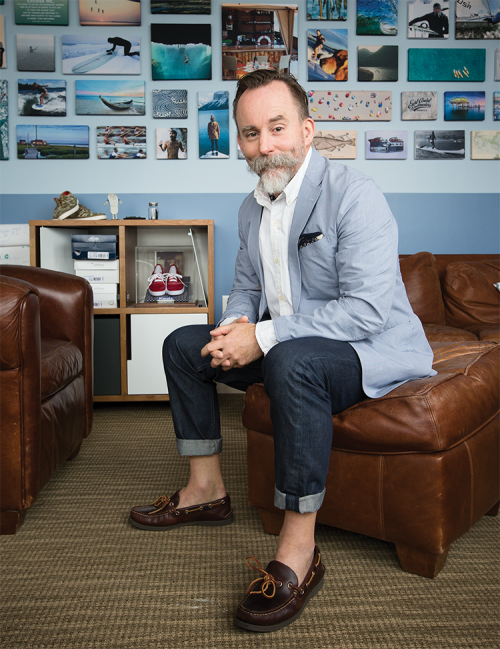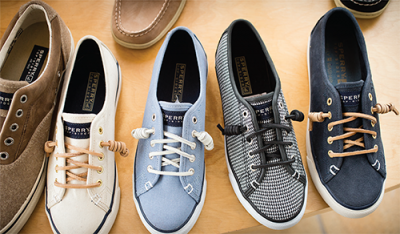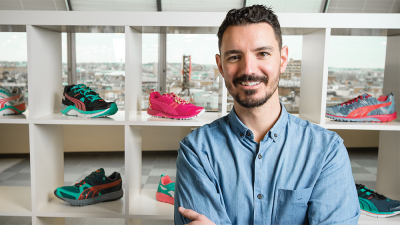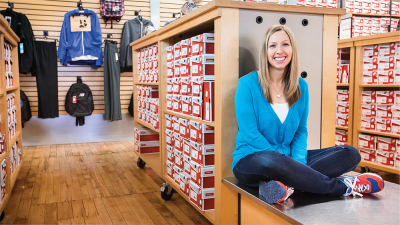
Whether you play basketball. Or run. Or compete in soccer, or some other sport. Whether you’re an aficionado of hip-hop culture. Or a fashionista. Or maybe even a collector. Chances are you own a pair—or two, or three—of sneakers.
Since their humble beginnings in the 1800s, sneakers, supposedly named for the stealthy quiet of their rubber soles, have captured the fancy of people around the world. In 2013, the global market for sneakers reached $55 billion, according to an analysis in Forbes, with about 40 percent of those sales in the U.S.
Sneakers also have captured the imagination of many from the Babson community, who give us a peek into this fun, fast-paced industry.
Rick Blackshaw ’85
President, Sperry Top-Sider, Lexington, Mass.

Rick Blackshaw ’85 in his office at Wolverine Worldwide.
For more than 20 years, Rick Blackshaw has worked in the footwear business, mostly focusing on sneakers. As a result, he has spent many hours trying to figure out the mindset of 13- to 24-year-olds. With two sets of teenage twins, 17-year-old daughters and 14-year-old sons (the boys are identical), he has somewhat of a home-field advantage. “I’ve learned a lot by peppering my children with questions every night at the dinner table,” he says.
Blackshaw says understanding young people at a deep level, and then responding with products that capture their imaginations before the competition does, remains one of the biggest challenges in this field. He currently works for Wolverine Worldwide, a global footwear and apparel company with 15 brands, as president of Sperry Top-Sider. Before that, he was president of Keds, also owned by Wolverine.
As president of Sperry, Blackshaw has a hand in most areas of its business, from product design to domestic and international distribution to brand management. The iconic Sperry Top-Sider dates back to 1935, when Paul Sperry invented his first pair of boat shoes. Blackshaw and his team currently are working to relaunch Sperry Top-Sider with a new brand identity; fresh strategies for its print, digital, and social media marketing; and a redesign of all stores. The new Sperry is looking for a stronger connection to young consumers, he says, with a focus that’s more “nautical grit” and less yacht club.
Igniting consumer passion takes a multifaceted approach in this era of social and digital media. “People obviously have access to information that they didn’t have before,” Blackshaw says. “From a trend perspective, say you’re a kid in Indiana who has no cool sneaker shops anywhere near you. Ten years ago, whatever your local sneaker retailer had was all you really knew about. Today with different blogs and websites, you can know everything that happened on the runway in Paris or London or Stockholm and buy something very similar in short order. Consumers just have more options. You have to really lodge your brand in their hearts and minds.”

Blackshaw believes in the staying power of iconic brands. He gives the example of Converse, where he served as vice president/general manager of the Chuck Taylor group. “When I got there in 2004, the prevailing wisdom was that there was a seven-year boom-and-bust to that shoe,” he says. When consumer demand waned, the company would drop the price of the shoe, which “would make it appear less cool.” The company sold about 2 million pairs of Chuck Taylors in 2002, and 10 years later, it sold 75 million pairs annually. “We found that if you’re able to connect to the hearts and minds of the consumers through great products as well as great marketing,” Blackshaw says, “you can defy any supposed cycle.”
When Blackshaw was president of Keds, he also made savvy moves to connect young girls and women with the brand, such as signing singer Taylor Swift as spokesperson. The process of wooing Swift took months. Blackshaw sensed that her management team was worried the Keds brand was too small for the megastar to endorse. In the end, though, Swift signed on because she had worn Keds as a child, and she liked the brand’s marketing campaign about bravery, which meshed well with her songs. “She occupies a very unique place for girls 13 to 24,” Blackshaw says. “Not only is she an incredible talent as a musician, songwriter, and performer, but she also happens to be a fashion icon.”
Blackshaw himself is known for his personal style. Bloomberg Businessweek recently featured him in its “What I Wear to Work” column, including a photo of Blackshaw wearing an ascot, vintage vest, jeans, and a pair of Sperry Top-Siders (of course). Blackshaw jokingly calls his look “aristocratic hobo.”
Clearly, Blackshaw fits well in the footwear business. “It’s a lot of fun,” he says, “because it combines fashion, design, marketing, and consumer insight.” Although sneakers may have been around for more than a century, the category still holds tremendous potential, he notes. The secret to growth, Blackshaw believes: “Making that connection of product and brand and consumer.”
Monica Ballin, MBA’12
Marketing Manager, Converse, North Andover, Mass.

Monica Ballin, MBA’12, shows off one of her many pairs of Converse sneakers.
Monica Ballin has an awesome sneaker collection, which she admits benefits from her job. As a Converse marketing manager who wears a size 7, the company’s sample size, she often scores free sneakers—not to mention the pairs she buys with her employee discount. “My closet is obnoxious,” she says.
Her current favorite pair is the Platform Plus, a wedge sneaker that came out in spring 2014. “I really like the height, and they’re so comfortable,” she says. Another favorite pair is the recently released Lux. “It’s another sneaker with a wedge but with a slightly shorter shaft, making it look even better on your foot,” she says.
Before working in the sneaker industry, Ballin was at a boutique PR firm in Los Angeles. A desire to reboot her career and focus on more tangible products brought her to the Babson MBA program. A previous brief stint at Reebok had introduced her to the athletic shoe industry, which she loved, and she initially hoped her MBA would help her land a job in product development at a similar company. But then she decided to focus on marketing instead.
Now in her third year at Converse, Ballin says she made the right move. “Footwear is something I’m passionate about,” she says. “Not only do I get to work in footwear, but I also work for a brand that I’ve loved since I was a teenager and that I connect with as a consumer.”
Ballin is part of a team that oversees the North American marketing for Converse’s Jack Purcell franchise, one of the company’s four main product lines alongside Chuck Taylor All Star, Cons, and Kids. She handles “everything from soup to nuts,” which means being part of a team that creates marketing plans for the brand and wholesale partners.
“Converse’s success has been their consumer-led focus, in which all decisions are based on the needs of the consumer,” says Ballin. The Chuck Taylor All Star, once popular as a basketball shoe, now is considered a lifestyle sneaker. Its customers tend to be involved in creative expression, such as art or music. The typical Cons customers are more interested in the skateboard culture. The Jack Purcell franchise is named for a Canadian badminton player who designed the shoe in 1935 to wear on the badminton court. “Jack Purcell consumers are obsessed with the details and quality of the product,” she says. “They crave comfort, craft, and versatility in their footwear.”
Ballin says the strength of the Converse brand makes her job especially fun. “Our brand is well-known and understood by consumers, and we have products that people love,” says Ballin. “It just makes my job a lot more enjoyable, because we are marketing an authentic message. We’re not trying to convince them to buy anything at the end of the day.”
Steven Keating, MBA’15
Head of Design for Running/Training, Puma, Boston

Steven Keating, MBA’15, in the downtown Boston office of Puma.
As head of design for running and training sneakers at Puma, Steven Keating once flew to Iceland during the winter to conduct wear-testing with an elite Swedish runner. Keating hung off the side of a Land Rover in freezing temperatures to keep up with the runner and find out how the shoes felt.
But ask Keating what his biggest challenge is, and he’ll answer that it’s leading a team of designers. As creative, imaginative people, designers “find inspiration in many different ways and don’t always follow the rules,” he says with a laugh.
Keating started his career in sneakers working for Saucony, which is known for its running shoes. Soon after graduating with a bachelor’s degree in graphic design, he accepted an internship creating catalogs and other marketing materials at the company. As the internship drew to a close, the senior vice president of marketing and products invited Keating to step into an open position on the footwear design team on a trial basis. Within six months, he was a permanent member of the team.
He found the switch from 2-D to 3-D exciting. “Graphic design is all about the layouts and composition,” Keating says. “All of a sudden, I had to make a brain shift to doing the same thing in three dimensions, and making a product that people rely on to prevent injury while running. It adds a lot of complexity to the process, and that’s one of the things I love about it.”
Keating left Saucony for a new opportunity at Puma in 2010 and was soon promoted to his current position. But he sensed that he needed stronger business and management skills, so in 2013, he began earning his MBA. “I knew the design side of things,” he says, “but I didn’t really know the overall business, and I just wanted to become a better manager.”
Putting his education to work right away, Keating established a mentorship program in the design department that has become a model for the rest of the company. He tries to foster a fun atmosphere in the office, citing the “serious arsenal of Nerf guns” that gets frequent use. He and his team once watched a documentary about mid-century modern designers Ray and Charles Eames and then began sketching shoe ideas based on the couple’s iconic Eames rocker and lounger. “I need to increase revenue for the company, but I also need to keep a design team happy and keep them motivated and inspired,” he says. “These two things sometimes are really hard to manage.”
At Saucony, Keating worked on technical shoes for runners. At Puma, he says, “We ride this knife edge of technicality and lifestyle. So we have two consumers in mind while designing: The guy who is training to run a marathon, and the consumer who will wear the shoe with jeans and just wants to look really good.” Signs of success for Keating: Puma’s Faas 100 v3 running shoe recently received high marks from Runner’s World magazine and also was chosen as the top sneaker by Hypebeast, an online style magazine for men.
Customer demands have changed rapidly during the last 10 years, says Keating. When he started at Saucony, the company emphasized big, overbuilt, technical shoes with plenty of cushioning. That changed dramatically with the popularity of the Vibram FiveFingers, thin-soled shoes meant to mimic the sensation of running barefoot. In response, companies created super-minimal, low-profile, light shoes. Since then, however, “the pendulum is swinging back,” says Keating, “so that people are asking for a bit more support, a bit more protection.”
As a head of design, Keating has had the chance to work with top international runners. Before the 2012 Summer Olympics, he traveled to Jamaica to give sprinter Usain Bolt a presentation on the shoes Puma designed for him to wear during the games. (Puma uses a 3-D scan of Bolt’s feet to build his shoes, says Keating, and the iridescent white color of Bolt’s Olympic shoes was selected to contrast with the blue track.)
He also makes periodic trips to Vietnam to meet with manufacturers and visits countries just for style inspiration. He has traveled to 15 countries in the three years since joining Puma, an especially impressive feat given his wife recently had a baby and he has been juggling the Babson program for the last 18 months. On a recent trip to Amsterdam, Keating gathered with about 30 other Puma designers to talk trends and shape the creative direction for the autumn-winter 2016 lines. “Trips like that remind me how much fun my job is,” he says. “Not every day is like that, but I get a lot more days like this than most people, so I feel lucky.”
Barry Katz, MBA’09
Founder, Ektio, Bridgewater, N.J.

Photo: Winnie Au
Barry Katz, MBA’09, tries out his Ektio sneakers on the basketball court.
Barry Katz is on a mission to prevent the top injury among basketball players: ankle sprains. When he was a basketball player in high school and college, Katz suffered three severe ankle sprains on the court. Now a radiologist with expertise in orthopedics, he knows that repeated ankle sprains can end a player’s career.
So Katz founded Ektio, which makes a basketball shoe designed to prevent ankle sprains. Most sprains occur when players jump and then land on someone else’s foot, says Katz. The foot rolls over on this uneven surface, triggering the sprain. Katz blames typical basketball shoes for making the situation worse; as the player lands, the shoe moves one way, and the foot goes the other.
He teamed up with an orthopedic surgeon and podiatrist to develop his shoes, which keep the foot stable and prevent rollovers. Ektio shoes include two built-in straps, one that crosses the ankle joint and one that wraps all the way around the ankle. “This really locks your foot into the shoe,” Katz says. The outer edge of each shoe includes “outriggers” or bumpers to further prevent rollover. “There’s no other solution on the market right now that can reliably reduce or prevent ankle sprains,” Katz says. “Wearing tape and braces doesn’t generally prevent ankle injuries, because you are still wearing a shoe that can roll over.”
While he was an MBA student at Babson, Katz explored the Ektio idea with a group of classmates, and they made the shoe the focus of their capstone project. After graduation in 2009, Katz continued to pursue the idea while working full time as a radiologist. He sold his first pair in November 2010 and since then has sold upwards of 18,000 more. In addition to Ektio’s website, the shoes are available online from Champs, Dick’s Sporting Goods, Amazon, and Eastbay.
Katz has introduced new models every few years, incorporating improvements each time. The most recent, the Alexio, has more durable midsole and outsole layers. “In our shoes, the foot becomes part of the shoe, which means you’re putting a lot of stress on the shoe when you make short stops and bursts,” Katz says. He and his team also changed the strap configuration to make the shoe easier to put on.
Ektio has just three permanent employees: Katz; his son, John, an MBA student at New York University who handles sales and marketing; and his wife, Carol, who handles operations and billing. Other work, such as sneaker design and manufacturing, currently is handled by freelance consultants. Katz would like to hire more employees to help grow the business, but he has found raising enough capital to be difficult. “Of course, it’s always a challenge,” Katz says, but he suspects that investors may be wary of investing in such a competitive space. So Katz is planning to launch a crowdfunding campaign on Kickstarter this year.
He has big plans. Katz wants to use this technology in other types of shoes, including construction boots, hiking boots, and shoes for tennis and volleyball, and he’s also looking for potential licensing partners. “I know our product is going to help people,” he says. “It’s going to help people who have never sprained an ankle to protect their ankles. And if people have had a sprain, this is going to give them the opportunity to play sports with much more confidence.”
Kira Zaiger, MBA’04
Senior Manager, Sourcing, Business Operations, New Balance, Lawrence, Mass.

Kira Zaiger, MBA’04, in one of New Balance’s outlet stores.
For Kira Zaiger, working in the athletic shoe industry means watching out for floods in Indonesia, monitoring strife in Vietnam, and planning around the New Year in China.
Zaiger manages the team that handles sourced manufacturing for all New Balance shoes. She and her colleagues determine which factories are available to produce the right number of shoes in the right time frame. Then they oversee production to ensure shipments leave the factories on time. Although one out of every four pairs of shoes that New Balance sells in the U.S. is made or assembled here, many are manufactured in Asia, which means Zaiger has to consider current conditions in these countries as she and her team make decisions.
Chinese New Year, for example, challenges anyone doing business in China, Zaiger says. Workers travel to visit their families for the February holiday, and factories generally shut down for two to three weeks. Complicating matters, New Balance has a high-capacity requirement in February for autumn and winter products. So Zaiger’s team works hard to prepare for these hurdles. “We try to get better at it every year,” she says, “but there always seems to be something new to add to the situation.”
After working many years in the apparel industry for companies such as Talbots and Liz Claiborne, Zaiger joined New Balance almost three years ago, making her “a relative newbie.” The last year has been particularly challenging for the company, but in a good way. “We’ve experienced incredible growth this year, which is great, but a lot of it happened very fast,” she says. “This year has been about ramping up capacity to address the greater demand.”
The company’s international markets have taken off, especially in Japan and China. “The brand has really caught fire,” says Zaiger. Expectations are for this growth to continue, and Zaiger will help plan for the brand’s global future.
New Balance is growing in the United States as well, driven in part by ramped-up marketing campaigns. The big news in Boston last year was that Red Sox slugger David Ortiz switched his endorsement to New Balance, says Zaiger. As New Englanders, she and her colleagues find it fun watching Red Sox games to try to see who else is wearing New Balance cleats, and she has grown skilled at spotting her company’s shoes at a distance. “It’s funny. It’s now more of a test to see if I can tell which style it is,” she says.
In her three years in the sneaker business, Zaiger has noticed an emphasis on lean manufacturing over the quest to find cheaper workers. The lean approach involves improving productivity with automation, new management approaches, and designs that are easier to manufacture. “You can’t continue to chase cheap labor,” Zaiger says, especially while maintaining New Balance’s quality standards and desire to be socially responsible, which includes ensuring safe conditions for factory workers.
Zaiger travels to Asia up to three times a year. The visits remind her of how many people are involved in the process of manufacturing a sneaker. “You walk into these factories, and there are thousands of people who are building these shoes,” she says. “There’s someone who’s touching every single part of the shoe.”
Thinking about all the stages a sneaker goes through until it reaches the customer can boggle the mind, says Zaiger. Going from initial design concept to store displays, when hopefully the sneaker’s style is trending in popularity, takes about 18 months. “It’s almost amazing when it’s done correctly,” she says. “Sometimes when I see the shoe on someone’s foot, I think, ‘Oh, my gosh. I know the whole story there.’”
